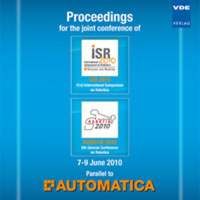Image Processing for Sensing Guide Wire Behaviour during Endovascular Surgery Simulation
Konferenz: ISR/ROBOTIK 2010 - ISR 2010 (41st International Symposium on Robotics) and ROBOTIK 2010 (6th German Conference on Robotics)
07.06.2010 - 09.06.2010 in Munich, Germany
Tagungsband: ISR/ROBOTIK 2010
Seiten: 6Sprache: EnglischTyp: PDF
Persönliche VDE-Mitglieder erhalten auf diesen Artikel 10% Rabatt
Autoren:
Tercero, Carlos; Ikeda, Seiichi; Fukuda, Toshio (Department of Micro-Nano Systems Engineering, Furo-cho 1, 464-8603, Nagoya, Japan)
Negoro, Makoto (Department of Neurosurgery, Fujita Health University, Kutsukake-cho, 470-1192, Toyoake, Japan)
Inhalt:
Vascular diseases are a major cause of death; therefore it is desirable to develop simulation techniques and robotic systems for endovascular surgery simulation. When the simulation is performed by human or robot, it is necessary to describe with quantitative data the interaction between the guide wire and the blood vessel models wall to make an objective evaluation of the procedure. As instantaneous evaluation parameters we have identified the guide wire tip location, vessel wall deformation and stress. In this research we present an image processing module for sensing those parameters in a model of carotid artery, which is composed of filtering techniques for source images noise reduction and target identification, a searching algorithm for the guide wire tip location, and a correction method for photoelastic stress analysis in blood vessel models with bifurcations. Images of a desired trajectory and case studies were analyzed in terms of blood vessel wall deformation, guide wire presence, shape, and tip location in less than 463ms. Photoelastic Stress analysis and stress distribution correction were applied to a set of images of the carotid artery model with an inner pressure range from 40 to 190 mmHg. This enables feedback control using image processing for the catheter insertion robot and guide wire trajectory analysis after the simulation.


